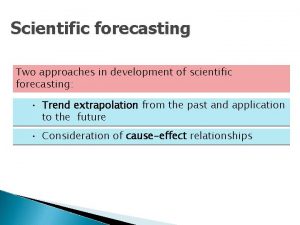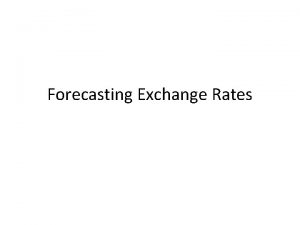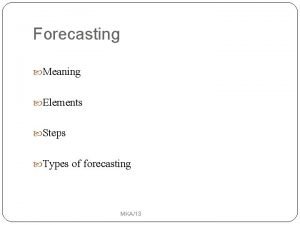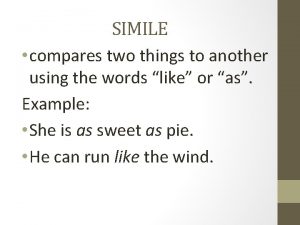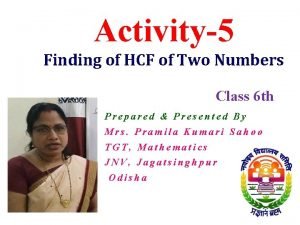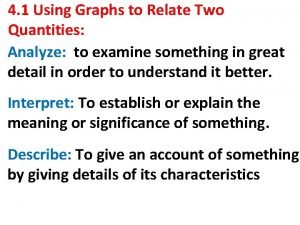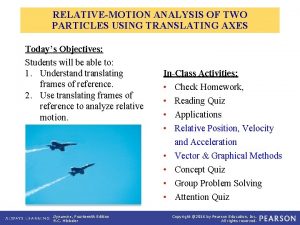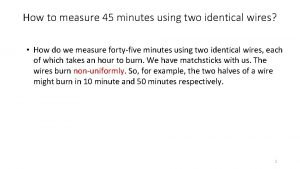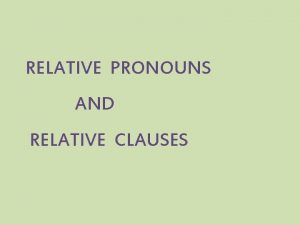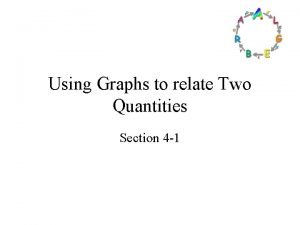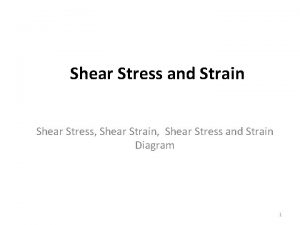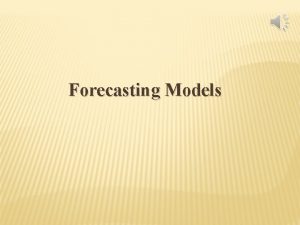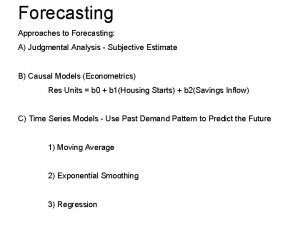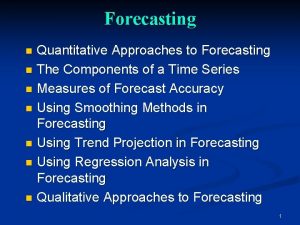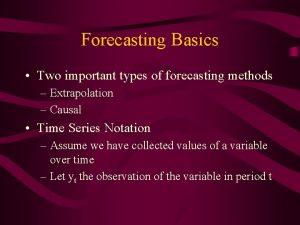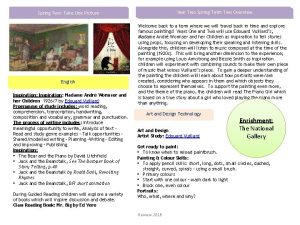Overview of Forecasting Two Approaches to Forecasting Using




















- Slides: 20

Overview of Forecasting

Two Approaches to Forecasting Using Survey Data (QMETH 520) Model Based Using Past Data Forecasting Methods (QMETH 530) Judgmental (NB: Ch. 11)

Past Data • Time Series – Variables observed in equal time space – Frequency • Daily, Weekly, Monthly, Quarterly, Yearly, etc.

Steps for Statistical Forecasting 1. Determine the variable(s) 2. Collect data • Frequency • Range 3. Develop a forecasting model (DGP) 4. Determine the forecast horizon 5. Determine the forecast statement

Data Sources • Public – Links to several data sources available on the Courses Web • Private

Forecast • Horizon – h step ahead – Short run – Long run h small h large • Statement – Point (unbiased and small se) – Interval (confidence level) – Density

Loss Functions • L(e=y – pred_y) L 0 L e 0 e

Example Variable: Japanese Yen per US Dollar Frequency: Monthly Data Range: 1980: 1 – 2000: 3 Forecast Horizon: 2000: 4 - 2002: 7

Forecasting Model • Statistical (scientific) forecast uses a “model” for determining the forecast statement. • Model = Data Generating Process (DGP)

Standard Forecasting Models • See the list in the syllabus

Modeling Process • We do not reinvent a new wheel • We “match data” with a “standard model” Data Standard Forecasting Models

Importance of Coverage • Merit in learning a variety of forecasting models – Rather than mastering a one particular model • For time series data – To cope with different types of “dynamics” • Survey data – To cope with different types of “variables”

Variety of Dynamics • Data = Trend + Season + Cycle + Irregular • Irregular – Equal Variance – Unequal Variance

Implications of Using Standard Models • Democratization of forecasting technology • Transparency of forecasting process • Identify the weaknesses of modeling – Imperfect model – Not enough observations – Contaminated data

Role of Software • Graphical display of data – Guiding the choice of models • Data Analysis: Matching Process – Fitting standard models supported in the software – Testing the adequacy of the models after fitting • Forecast – Computing forecasts

Forecasting in Action • Operations Planning and Control – Inventory management – sales force management – production planning, etc. • Marketing – pricing decisions – advertisement expenditure decisions

Forecasting in Action - cont. • Economics – macroeconomics variables – business cycles • Business and Government Budgeting – revenue forecasting – expenditure forecasting • Demography – population – immigration, emigration – incidence rate

Forecasting in Action - cont. • Human Resource Management – employee performance • Risk Management – credit scoring • Financial Speculation – stock returns – interest rates – exchange rates

Models Components Forecasting Model Trend Fixed vs. Variable Season Fixed vs. Variables Cycle ARMA Irregular Random / GARCH

Statistical Thinking for Management World Data Information about a few customers, incidents Statistics not used Represent many others Identify the relevant Process Statistical methods needed
 What are the two types of forecasting
What are the two types of forecasting The main approaches to forecasting exchange rates are
The main approaches to forecasting exchange rates are Corporate governance is which approach
Corporate governance is which approach The two dominant agile approaches are
The two dominant agile approaches are Forecast horizon
Forecast horizon Using system using system.collections.generic
Using system using system.collections.generic Accumulator ac
Accumulator ac A simile compares two things
A simile compares two things Use the following pictures to compare
Use the following pictures to compare Simile definition
Simile definition A comparison of two unlike things using like or as
A comparison of two unlike things using like or as To find the hcf of two numbers using activity method
To find the hcf of two numbers using activity method Using graphs to relate two quantities
Using graphs to relate two quantities Relative motion of two particles using translating axes
Relative motion of two particles using translating axes Polynomial multiplication using linked list in c
Polynomial multiplication using linked list in c Literary techniques comparison
Literary techniques comparison How to measure 45 minutes using two identical wires
How to measure 45 minutes using two identical wires Join the sentences using relative pronouns
Join the sentences using relative pronouns Comparing two things without using like or as
Comparing two things without using like or as Using graphs to relate two quantities
Using graphs to relate two quantities Factor of safety formula yield strength
Factor of safety formula yield strength
